A Critical Analysis of Cancer Research UK's Anti-Obesity Campaign
VerifiedAdded on 2023/04/21
|10
|2775
|189
Report
AI Summary
This report provides a critical analysis of Cancer Research UK's PR campaign focused on anti-obesity efforts in February 2018. It begins with an introduction to the importance of public relations (PR) for organizations and the role of campaigns in shaping public image. The report then delves into various PR theories, including the communication model, Grunig's four models of public relations (press agentry, public information, two-way symmetrical, and two-way asymmetrical), and the theory of persuasion. It also discusses the PR planning process. An overview of Cancer Research UK's campaign is presented, highlighting its message and the public's reaction, including criticisms of 'fat-shaming.' The analysis applies the PR theories to the campaign, assessing its effectiveness. The report concludes with recommendations for future campaigns, such as conducting thorough demographic studies, avoiding assumptions, and consulting the target audience. The overall aim is to evaluate the campaign and offer insights for improving future PR strategies.
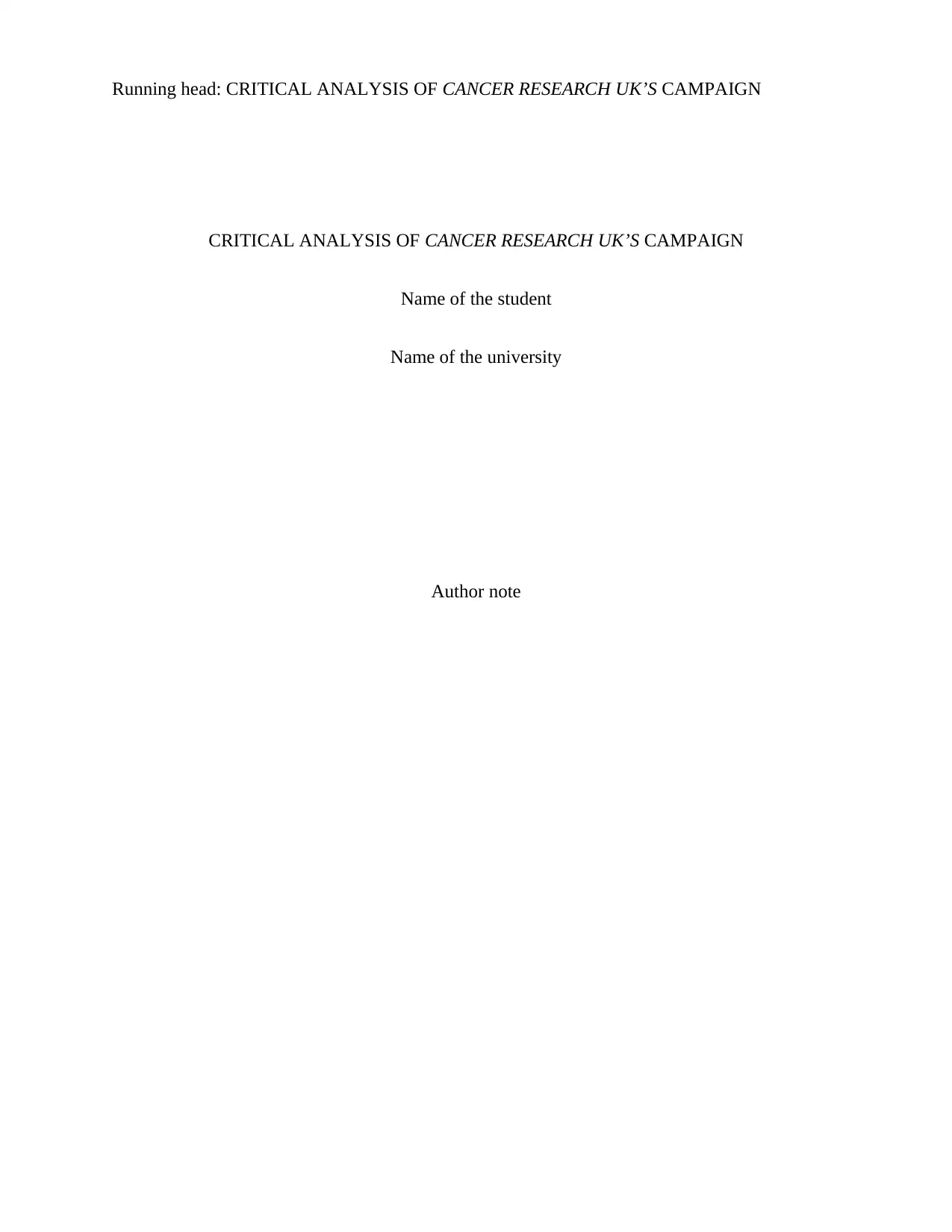
Running head: CRITICAL ANALYSIS OF CANCER RESEARCH UK’S CAMPAIGN
CRITICAL ANALYSIS OF CANCER RESEARCH UK’S CAMPAIGN
Name of the student
Name of the university
Author note
CRITICAL ANALYSIS OF CANCER RESEARCH UK’S CAMPAIGN
Name of the student
Name of the university
Author note
Paraphrase This Document
Need a fresh take? Get an instant paraphrase of this document with our AI Paraphraser
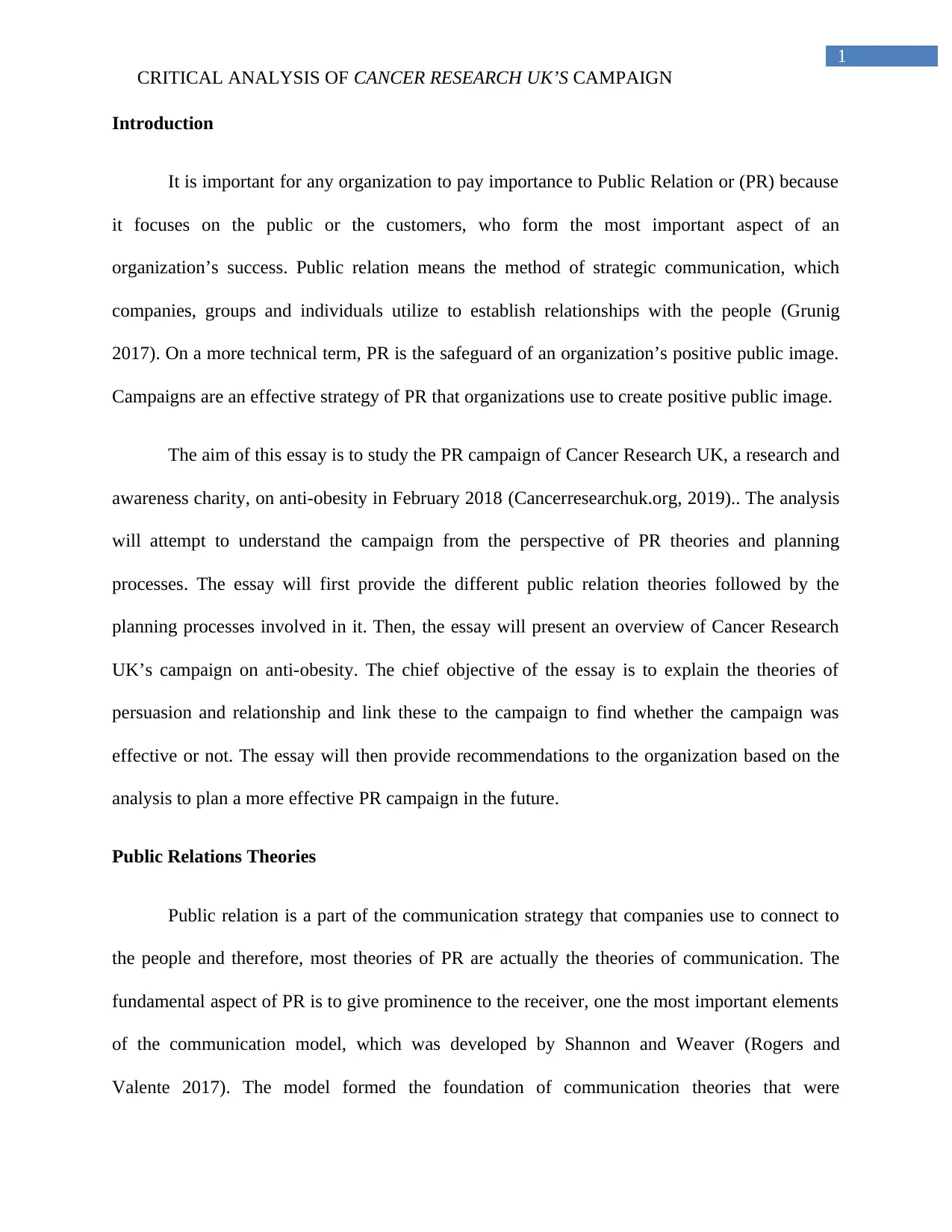
1
CRITICAL ANALYSIS OF CANCER RESEARCH UK’S CAMPAIGN
Introduction
It is important for any organization to pay importance to Public Relation or (PR) because
it focuses on the public or the customers, who form the most important aspect of an
organization’s success. Public relation means the method of strategic communication, which
companies, groups and individuals utilize to establish relationships with the people (Grunig
2017). On a more technical term, PR is the safeguard of an organization’s positive public image.
Campaigns are an effective strategy of PR that organizations use to create positive public image.
The aim of this essay is to study the PR campaign of Cancer Research UK, a research and
awareness charity, on anti-obesity in February 2018 (Cancerresearchuk.org, 2019).. The analysis
will attempt to understand the campaign from the perspective of PR theories and planning
processes. The essay will first provide the different public relation theories followed by the
planning processes involved in it. Then, the essay will present an overview of Cancer Research
UK’s campaign on anti-obesity. The chief objective of the essay is to explain the theories of
persuasion and relationship and link these to the campaign to find whether the campaign was
effective or not. The essay will then provide recommendations to the organization based on the
analysis to plan a more effective PR campaign in the future.
Public Relations Theories
Public relation is a part of the communication strategy that companies use to connect to
the people and therefore, most theories of PR are actually the theories of communication. The
fundamental aspect of PR is to give prominence to the receiver, one the most important elements
of the communication model, which was developed by Shannon and Weaver (Rogers and
Valente 2017). The model formed the foundation of communication theories that were
CRITICAL ANALYSIS OF CANCER RESEARCH UK’S CAMPAIGN
Introduction
It is important for any organization to pay importance to Public Relation or (PR) because
it focuses on the public or the customers, who form the most important aspect of an
organization’s success. Public relation means the method of strategic communication, which
companies, groups and individuals utilize to establish relationships with the people (Grunig
2017). On a more technical term, PR is the safeguard of an organization’s positive public image.
Campaigns are an effective strategy of PR that organizations use to create positive public image.
The aim of this essay is to study the PR campaign of Cancer Research UK, a research and
awareness charity, on anti-obesity in February 2018 (Cancerresearchuk.org, 2019).. The analysis
will attempt to understand the campaign from the perspective of PR theories and planning
processes. The essay will first provide the different public relation theories followed by the
planning processes involved in it. Then, the essay will present an overview of Cancer Research
UK’s campaign on anti-obesity. The chief objective of the essay is to explain the theories of
persuasion and relationship and link these to the campaign to find whether the campaign was
effective or not. The essay will then provide recommendations to the organization based on the
analysis to plan a more effective PR campaign in the future.
Public Relations Theories
Public relation is a part of the communication strategy that companies use to connect to
the people and therefore, most theories of PR are actually the theories of communication. The
fundamental aspect of PR is to give prominence to the receiver, one the most important elements
of the communication model, which was developed by Shannon and Weaver (Rogers and
Valente 2017). The model formed the foundation of communication theories that were
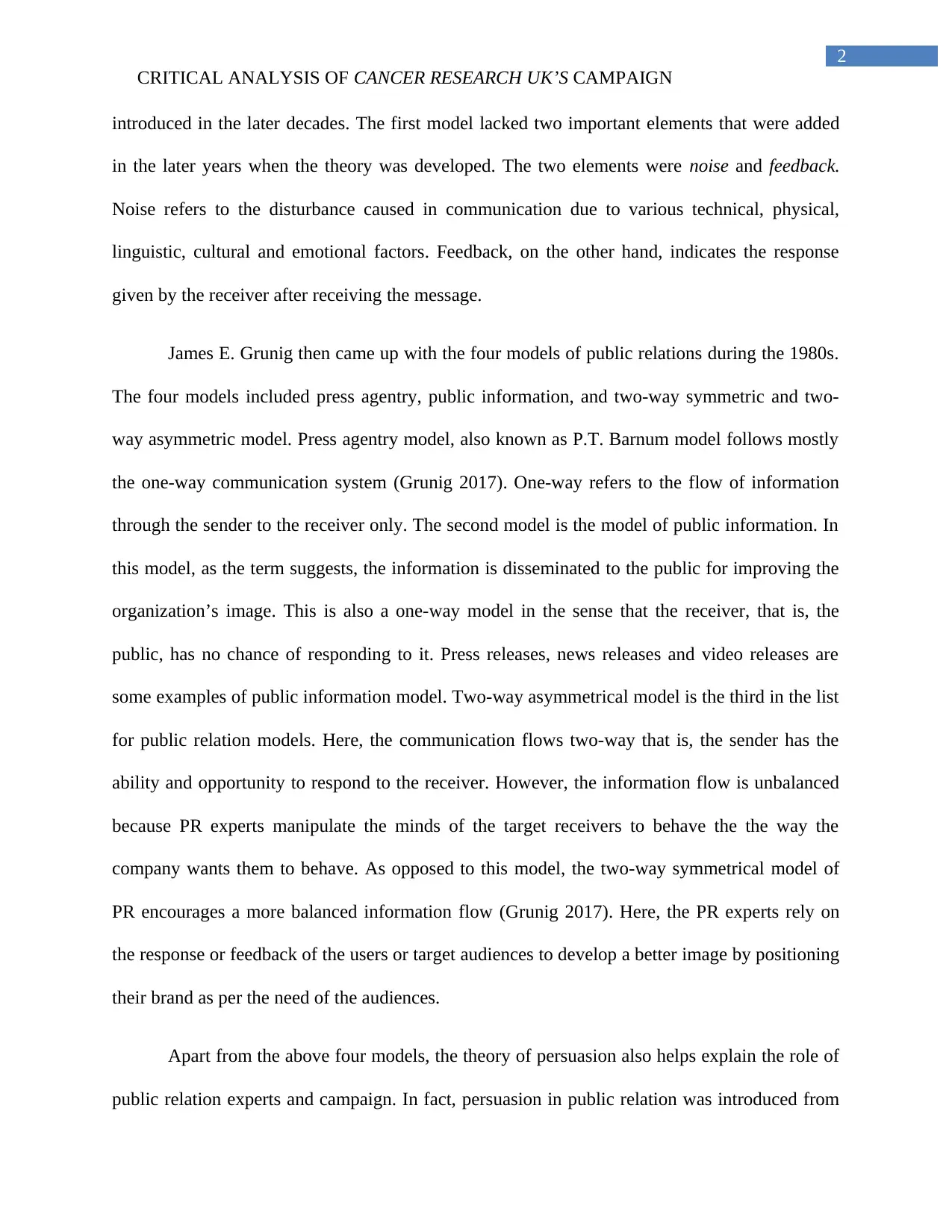
2
CRITICAL ANALYSIS OF CANCER RESEARCH UK’S CAMPAIGN
introduced in the later decades. The first model lacked two important elements that were added
in the later years when the theory was developed. The two elements were noise and feedback.
Noise refers to the disturbance caused in communication due to various technical, physical,
linguistic, cultural and emotional factors. Feedback, on the other hand, indicates the response
given by the receiver after receiving the message.
James E. Grunig then came up with the four models of public relations during the 1980s.
The four models included press agentry, public information, and two-way symmetric and two-
way asymmetric model. Press agentry model, also known as P.T. Barnum model follows mostly
the one-way communication system (Grunig 2017). One-way refers to the flow of information
through the sender to the receiver only. The second model is the model of public information. In
this model, as the term suggests, the information is disseminated to the public for improving the
organization’s image. This is also a one-way model in the sense that the receiver, that is, the
public, has no chance of responding to it. Press releases, news releases and video releases are
some examples of public information model. Two-way asymmetrical model is the third in the list
for public relation models. Here, the communication flows two-way that is, the sender has the
ability and opportunity to respond to the receiver. However, the information flow is unbalanced
because PR experts manipulate the minds of the target receivers to behave the the way the
company wants them to behave. As opposed to this model, the two-way symmetrical model of
PR encourages a more balanced information flow (Grunig 2017). Here, the PR experts rely on
the response or feedback of the users or target audiences to develop a better image by positioning
their brand as per the need of the audiences.
Apart from the above four models, the theory of persuasion also helps explain the role of
public relation experts and campaign. In fact, persuasion in public relation was introduced from
CRITICAL ANALYSIS OF CANCER RESEARCH UK’S CAMPAIGN
introduced in the later decades. The first model lacked two important elements that were added
in the later years when the theory was developed. The two elements were noise and feedback.
Noise refers to the disturbance caused in communication due to various technical, physical,
linguistic, cultural and emotional factors. Feedback, on the other hand, indicates the response
given by the receiver after receiving the message.
James E. Grunig then came up with the four models of public relations during the 1980s.
The four models included press agentry, public information, and two-way symmetric and two-
way asymmetric model. Press agentry model, also known as P.T. Barnum model follows mostly
the one-way communication system (Grunig 2017). One-way refers to the flow of information
through the sender to the receiver only. The second model is the model of public information. In
this model, as the term suggests, the information is disseminated to the public for improving the
organization’s image. This is also a one-way model in the sense that the receiver, that is, the
public, has no chance of responding to it. Press releases, news releases and video releases are
some examples of public information model. Two-way asymmetrical model is the third in the list
for public relation models. Here, the communication flows two-way that is, the sender has the
ability and opportunity to respond to the receiver. However, the information flow is unbalanced
because PR experts manipulate the minds of the target receivers to behave the the way the
company wants them to behave. As opposed to this model, the two-way symmetrical model of
PR encourages a more balanced information flow (Grunig 2017). Here, the PR experts rely on
the response or feedback of the users or target audiences to develop a better image by positioning
their brand as per the need of the audiences.
Apart from the above four models, the theory of persuasion also helps explain the role of
public relation experts and campaign. In fact, persuasion in public relation was introduced from
⊘ This is a preview!⊘
Do you want full access?
Subscribe today to unlock all pages.

Trusted by 1+ million students worldwide
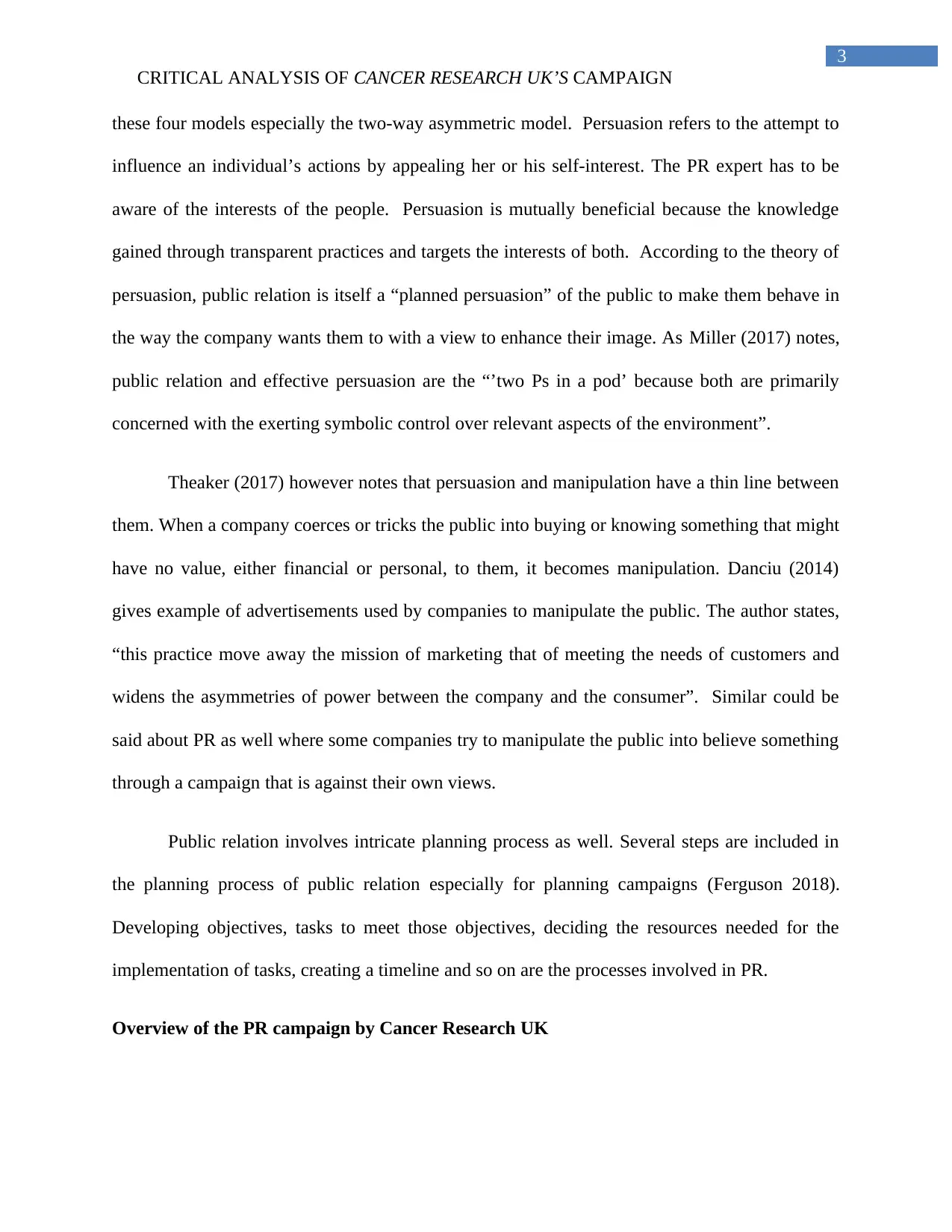
3
CRITICAL ANALYSIS OF CANCER RESEARCH UK’S CAMPAIGN
these four models especially the two-way asymmetric model. Persuasion refers to the attempt to
influence an individual’s actions by appealing her or his self-interest. The PR expert has to be
aware of the interests of the people. Persuasion is mutually beneficial because the knowledge
gained through transparent practices and targets the interests of both. According to the theory of
persuasion, public relation is itself a “planned persuasion” of the public to make them behave in
the way the company wants them to with a view to enhance their image. As Miller (2017) notes,
public relation and effective persuasion are the “’two Ps in a pod’ because both are primarily
concerned with the exerting symbolic control over relevant aspects of the environment”.
Theaker (2017) however notes that persuasion and manipulation have a thin line between
them. When a company coerces or tricks the public into buying or knowing something that might
have no value, either financial or personal, to them, it becomes manipulation. Danciu (2014)
gives example of advertisements used by companies to manipulate the public. The author states,
“this practice move away the mission of marketing that of meeting the needs of customers and
widens the asymmetries of power between the company and the consumer”. Similar could be
said about PR as well where some companies try to manipulate the public into believe something
through a campaign that is against their own views.
Public relation involves intricate planning process as well. Several steps are included in
the planning process of public relation especially for planning campaigns (Ferguson 2018).
Developing objectives, tasks to meet those objectives, deciding the resources needed for the
implementation of tasks, creating a timeline and so on are the processes involved in PR.
Overview of the PR campaign by Cancer Research UK
CRITICAL ANALYSIS OF CANCER RESEARCH UK’S CAMPAIGN
these four models especially the two-way asymmetric model. Persuasion refers to the attempt to
influence an individual’s actions by appealing her or his self-interest. The PR expert has to be
aware of the interests of the people. Persuasion is mutually beneficial because the knowledge
gained through transparent practices and targets the interests of both. According to the theory of
persuasion, public relation is itself a “planned persuasion” of the public to make them behave in
the way the company wants them to with a view to enhance their image. As Miller (2017) notes,
public relation and effective persuasion are the “’two Ps in a pod’ because both are primarily
concerned with the exerting symbolic control over relevant aspects of the environment”.
Theaker (2017) however notes that persuasion and manipulation have a thin line between
them. When a company coerces or tricks the public into buying or knowing something that might
have no value, either financial or personal, to them, it becomes manipulation. Danciu (2014)
gives example of advertisements used by companies to manipulate the public. The author states,
“this practice move away the mission of marketing that of meeting the needs of customers and
widens the asymmetries of power between the company and the consumer”. Similar could be
said about PR as well where some companies try to manipulate the public into believe something
through a campaign that is against their own views.
Public relation involves intricate planning process as well. Several steps are included in
the planning process of public relation especially for planning campaigns (Ferguson 2018).
Developing objectives, tasks to meet those objectives, deciding the resources needed for the
implementation of tasks, creating a timeline and so on are the processes involved in PR.
Overview of the PR campaign by Cancer Research UK
Paraphrase This Document
Need a fresh take? Get an instant paraphrase of this document with our AI Paraphraser
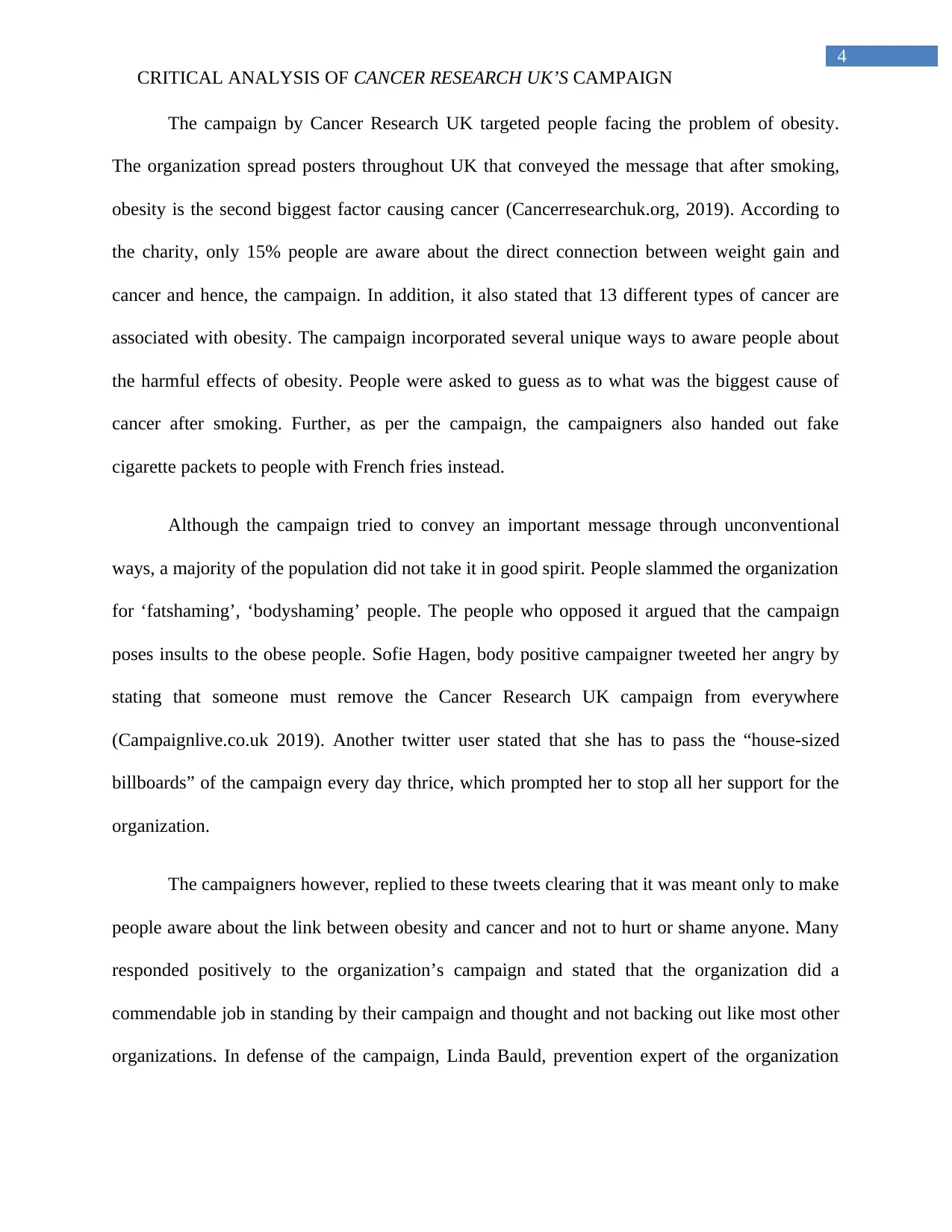
4
CRITICAL ANALYSIS OF CANCER RESEARCH UK’S CAMPAIGN
The campaign by Cancer Research UK targeted people facing the problem of obesity.
The organization spread posters throughout UK that conveyed the message that after smoking,
obesity is the second biggest factor causing cancer (Cancerresearchuk.org, 2019). According to
the charity, only 15% people are aware about the direct connection between weight gain and
cancer and hence, the campaign. In addition, it also stated that 13 different types of cancer are
associated with obesity. The campaign incorporated several unique ways to aware people about
the harmful effects of obesity. People were asked to guess as to what was the biggest cause of
cancer after smoking. Further, as per the campaign, the campaigners also handed out fake
cigarette packets to people with French fries instead.
Although the campaign tried to convey an important message through unconventional
ways, a majority of the population did not take it in good spirit. People slammed the organization
for ‘fatshaming’, ‘bodyshaming’ people. The people who opposed it argued that the campaign
poses insults to the obese people. Sofie Hagen, body positive campaigner tweeted her angry by
stating that someone must remove the Cancer Research UK campaign from everywhere
(Campaignlive.co.uk 2019). Another twitter user stated that she has to pass the “house-sized
billboards” of the campaign every day thrice, which prompted her to stop all her support for the
organization.
The campaigners however, replied to these tweets clearing that it was meant only to make
people aware about the link between obesity and cancer and not to hurt or shame anyone. Many
responded positively to the organization’s campaign and stated that the organization did a
commendable job in standing by their campaign and thought and not backing out like most other
organizations. In defense of the campaign, Linda Bauld, prevention expert of the organization
CRITICAL ANALYSIS OF CANCER RESEARCH UK’S CAMPAIGN
The campaign by Cancer Research UK targeted people facing the problem of obesity.
The organization spread posters throughout UK that conveyed the message that after smoking,
obesity is the second biggest factor causing cancer (Cancerresearchuk.org, 2019). According to
the charity, only 15% people are aware about the direct connection between weight gain and
cancer and hence, the campaign. In addition, it also stated that 13 different types of cancer are
associated with obesity. The campaign incorporated several unique ways to aware people about
the harmful effects of obesity. People were asked to guess as to what was the biggest cause of
cancer after smoking. Further, as per the campaign, the campaigners also handed out fake
cigarette packets to people with French fries instead.
Although the campaign tried to convey an important message through unconventional
ways, a majority of the population did not take it in good spirit. People slammed the organization
for ‘fatshaming’, ‘bodyshaming’ people. The people who opposed it argued that the campaign
poses insults to the obese people. Sofie Hagen, body positive campaigner tweeted her angry by
stating that someone must remove the Cancer Research UK campaign from everywhere
(Campaignlive.co.uk 2019). Another twitter user stated that she has to pass the “house-sized
billboards” of the campaign every day thrice, which prompted her to stop all her support for the
organization.
The campaigners however, replied to these tweets clearing that it was meant only to make
people aware about the link between obesity and cancer and not to hurt or shame anyone. Many
responded positively to the organization’s campaign and stated that the organization did a
commendable job in standing by their campaign and thought and not backing out like most other
organizations. In defense of the campaign, Linda Bauld, prevention expert of the organization
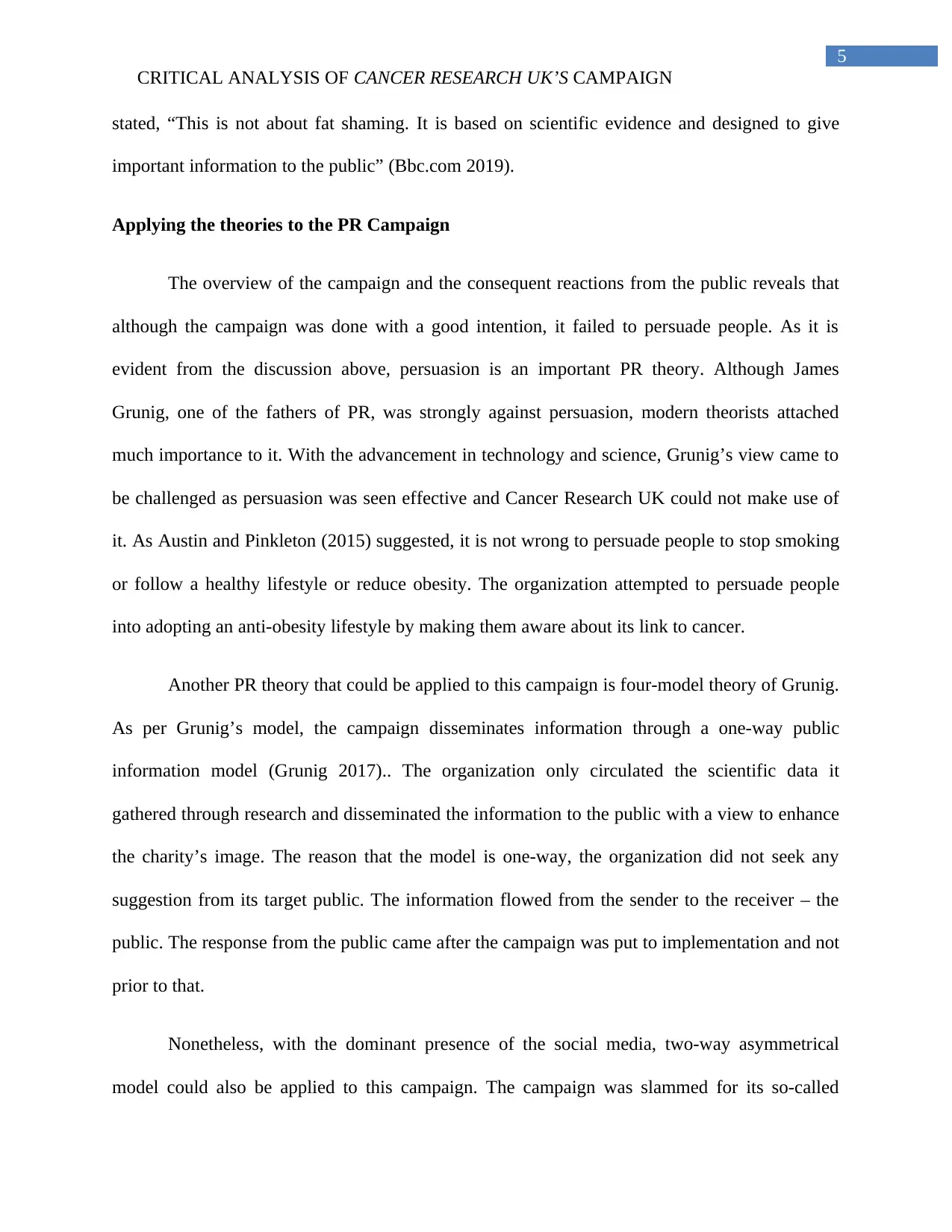
5
CRITICAL ANALYSIS OF CANCER RESEARCH UK’S CAMPAIGN
stated, “This is not about fat shaming. It is based on scientific evidence and designed to give
important information to the public” (Bbc.com 2019).
Applying the theories to the PR Campaign
The overview of the campaign and the consequent reactions from the public reveals that
although the campaign was done with a good intention, it failed to persuade people. As it is
evident from the discussion above, persuasion is an important PR theory. Although James
Grunig, one of the fathers of PR, was strongly against persuasion, modern theorists attached
much importance to it. With the advancement in technology and science, Grunig’s view came to
be challenged as persuasion was seen effective and Cancer Research UK could not make use of
it. As Austin and Pinkleton (2015) suggested, it is not wrong to persuade people to stop smoking
or follow a healthy lifestyle or reduce obesity. The organization attempted to persuade people
into adopting an anti-obesity lifestyle by making them aware about its link to cancer.
Another PR theory that could be applied to this campaign is four-model theory of Grunig.
As per Grunig’s model, the campaign disseminates information through a one-way public
information model (Grunig 2017).. The organization only circulated the scientific data it
gathered through research and disseminated the information to the public with a view to enhance
the charity’s image. The reason that the model is one-way, the organization did not seek any
suggestion from its target public. The information flowed from the sender to the receiver – the
public. The response from the public came after the campaign was put to implementation and not
prior to that.
Nonetheless, with the dominant presence of the social media, two-way asymmetrical
model could also be applied to this campaign. The campaign was slammed for its so-called
CRITICAL ANALYSIS OF CANCER RESEARCH UK’S CAMPAIGN
stated, “This is not about fat shaming. It is based on scientific evidence and designed to give
important information to the public” (Bbc.com 2019).
Applying the theories to the PR Campaign
The overview of the campaign and the consequent reactions from the public reveals that
although the campaign was done with a good intention, it failed to persuade people. As it is
evident from the discussion above, persuasion is an important PR theory. Although James
Grunig, one of the fathers of PR, was strongly against persuasion, modern theorists attached
much importance to it. With the advancement in technology and science, Grunig’s view came to
be challenged as persuasion was seen effective and Cancer Research UK could not make use of
it. As Austin and Pinkleton (2015) suggested, it is not wrong to persuade people to stop smoking
or follow a healthy lifestyle or reduce obesity. The organization attempted to persuade people
into adopting an anti-obesity lifestyle by making them aware about its link to cancer.
Another PR theory that could be applied to this campaign is four-model theory of Grunig.
As per Grunig’s model, the campaign disseminates information through a one-way public
information model (Grunig 2017).. The organization only circulated the scientific data it
gathered through research and disseminated the information to the public with a view to enhance
the charity’s image. The reason that the model is one-way, the organization did not seek any
suggestion from its target public. The information flowed from the sender to the receiver – the
public. The response from the public came after the campaign was put to implementation and not
prior to that.
Nonetheless, with the dominant presence of the social media, two-way asymmetrical
model could also be applied to this campaign. The campaign was slammed for its so-called
⊘ This is a preview!⊘
Do you want full access?
Subscribe today to unlock all pages.

Trusted by 1+ million students worldwide
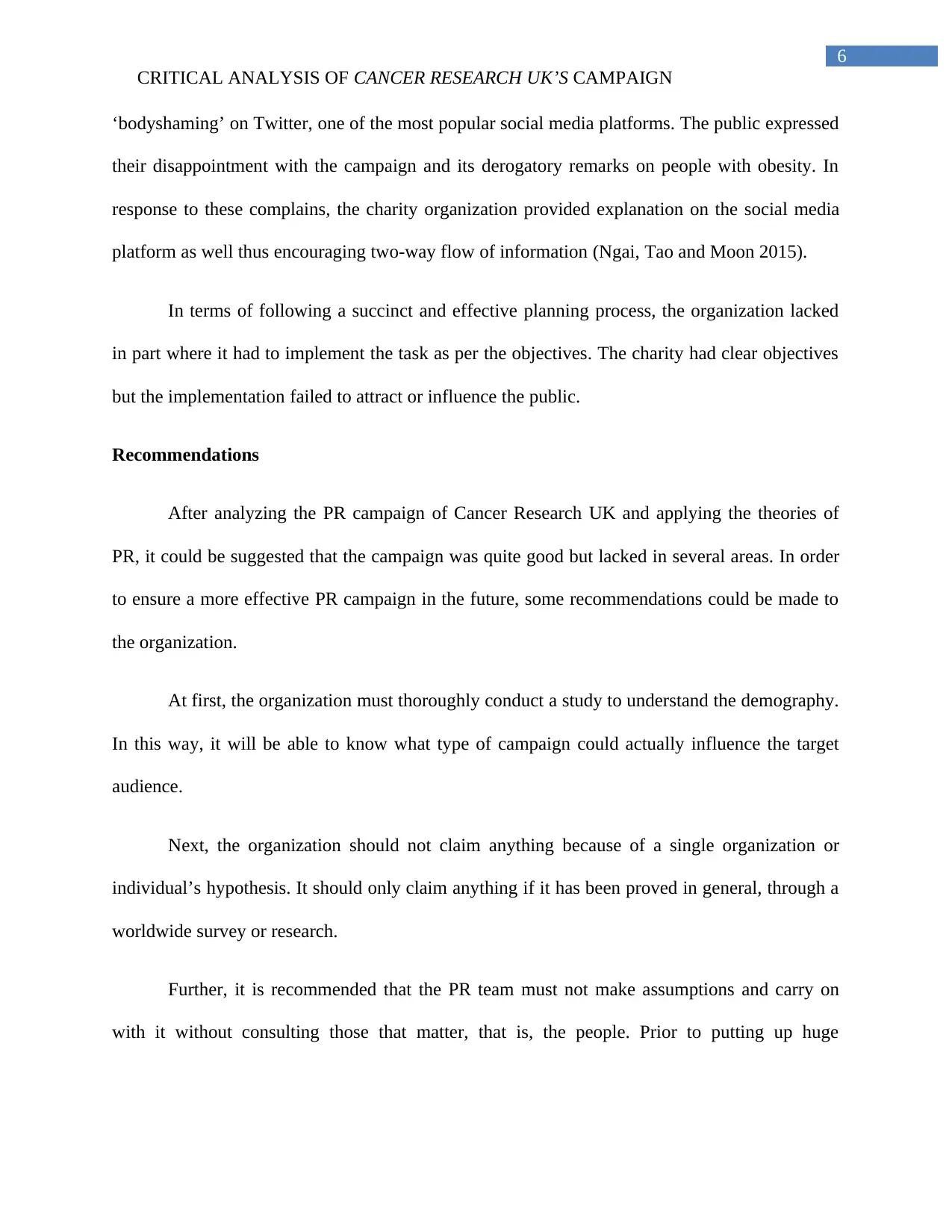
6
CRITICAL ANALYSIS OF CANCER RESEARCH UK’S CAMPAIGN
‘bodyshaming’ on Twitter, one of the most popular social media platforms. The public expressed
their disappointment with the campaign and its derogatory remarks on people with obesity. In
response to these complains, the charity organization provided explanation on the social media
platform as well thus encouraging two-way flow of information (Ngai, Tao and Moon 2015).
In terms of following a succinct and effective planning process, the organization lacked
in part where it had to implement the task as per the objectives. The charity had clear objectives
but the implementation failed to attract or influence the public.
Recommendations
After analyzing the PR campaign of Cancer Research UK and applying the theories of
PR, it could be suggested that the campaign was quite good but lacked in several areas. In order
to ensure a more effective PR campaign in the future, some recommendations could be made to
the organization.
At first, the organization must thoroughly conduct a study to understand the demography.
In this way, it will be able to know what type of campaign could actually influence the target
audience.
Next, the organization should not claim anything because of a single organization or
individual’s hypothesis. It should only claim anything if it has been proved in general, through a
worldwide survey or research.
Further, it is recommended that the PR team must not make assumptions and carry on
with it without consulting those that matter, that is, the people. Prior to putting up huge
CRITICAL ANALYSIS OF CANCER RESEARCH UK’S CAMPAIGN
‘bodyshaming’ on Twitter, one of the most popular social media platforms. The public expressed
their disappointment with the campaign and its derogatory remarks on people with obesity. In
response to these complains, the charity organization provided explanation on the social media
platform as well thus encouraging two-way flow of information (Ngai, Tao and Moon 2015).
In terms of following a succinct and effective planning process, the organization lacked
in part where it had to implement the task as per the objectives. The charity had clear objectives
but the implementation failed to attract or influence the public.
Recommendations
After analyzing the PR campaign of Cancer Research UK and applying the theories of
PR, it could be suggested that the campaign was quite good but lacked in several areas. In order
to ensure a more effective PR campaign in the future, some recommendations could be made to
the organization.
At first, the organization must thoroughly conduct a study to understand the demography.
In this way, it will be able to know what type of campaign could actually influence the target
audience.
Next, the organization should not claim anything because of a single organization or
individual’s hypothesis. It should only claim anything if it has been proved in general, through a
worldwide survey or research.
Further, it is recommended that the PR team must not make assumptions and carry on
with it without consulting those that matter, that is, the people. Prior to putting up huge
Paraphrase This Document
Need a fresh take? Get an instant paraphrase of this document with our AI Paraphraser
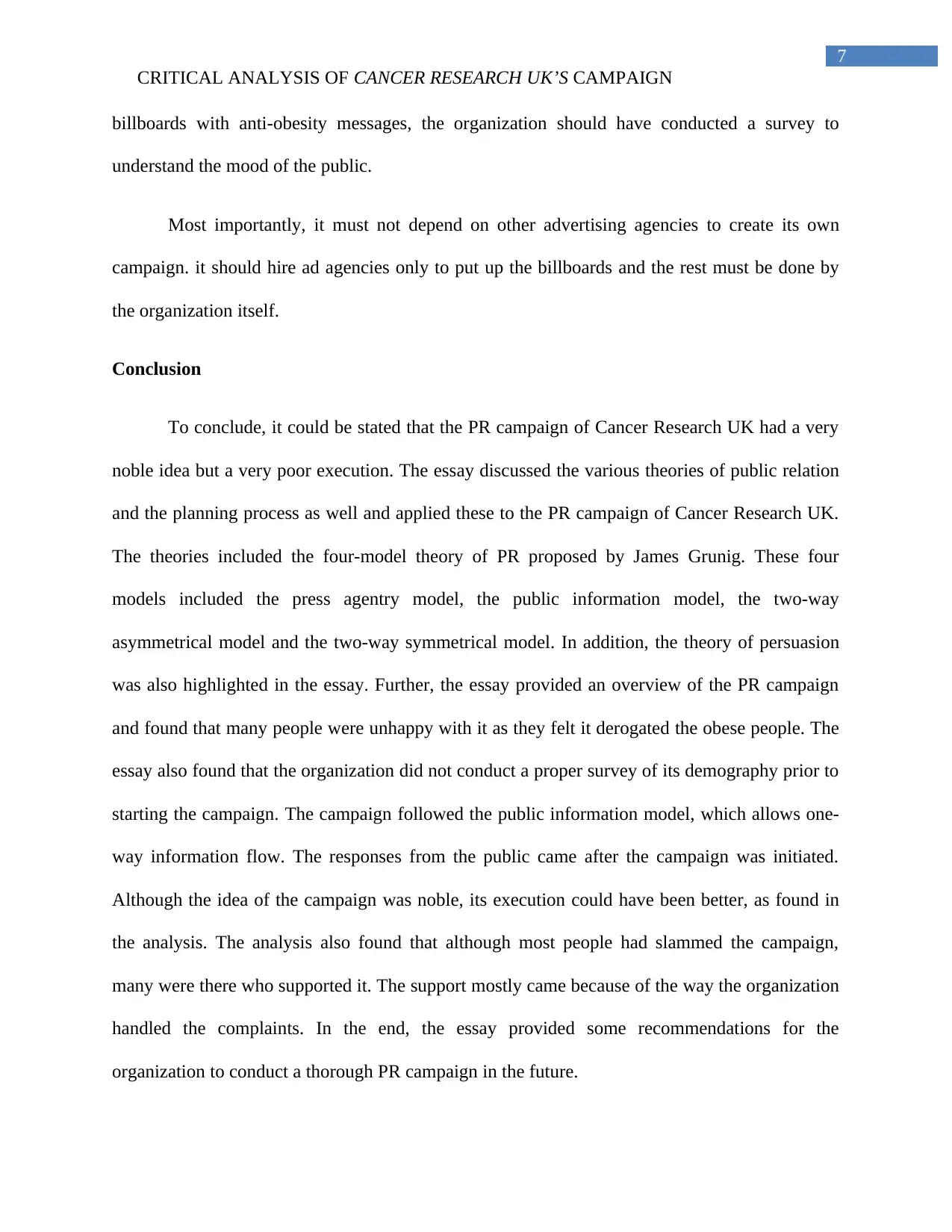
7
CRITICAL ANALYSIS OF CANCER RESEARCH UK’S CAMPAIGN
billboards with anti-obesity messages, the organization should have conducted a survey to
understand the mood of the public.
Most importantly, it must not depend on other advertising agencies to create its own
campaign. it should hire ad agencies only to put up the billboards and the rest must be done by
the organization itself.
Conclusion
To conclude, it could be stated that the PR campaign of Cancer Research UK had a very
noble idea but a very poor execution. The essay discussed the various theories of public relation
and the planning process as well and applied these to the PR campaign of Cancer Research UK.
The theories included the four-model theory of PR proposed by James Grunig. These four
models included the press agentry model, the public information model, the two-way
asymmetrical model and the two-way symmetrical model. In addition, the theory of persuasion
was also highlighted in the essay. Further, the essay provided an overview of the PR campaign
and found that many people were unhappy with it as they felt it derogated the obese people. The
essay also found that the organization did not conduct a proper survey of its demography prior to
starting the campaign. The campaign followed the public information model, which allows one-
way information flow. The responses from the public came after the campaign was initiated.
Although the idea of the campaign was noble, its execution could have been better, as found in
the analysis. The analysis also found that although most people had slammed the campaign,
many were there who supported it. The support mostly came because of the way the organization
handled the complaints. In the end, the essay provided some recommendations for the
organization to conduct a thorough PR campaign in the future.
CRITICAL ANALYSIS OF CANCER RESEARCH UK’S CAMPAIGN
billboards with anti-obesity messages, the organization should have conducted a survey to
understand the mood of the public.
Most importantly, it must not depend on other advertising agencies to create its own
campaign. it should hire ad agencies only to put up the billboards and the rest must be done by
the organization itself.
Conclusion
To conclude, it could be stated that the PR campaign of Cancer Research UK had a very
noble idea but a very poor execution. The essay discussed the various theories of public relation
and the planning process as well and applied these to the PR campaign of Cancer Research UK.
The theories included the four-model theory of PR proposed by James Grunig. These four
models included the press agentry model, the public information model, the two-way
asymmetrical model and the two-way symmetrical model. In addition, the theory of persuasion
was also highlighted in the essay. Further, the essay provided an overview of the PR campaign
and found that many people were unhappy with it as they felt it derogated the obese people. The
essay also found that the organization did not conduct a proper survey of its demography prior to
starting the campaign. The campaign followed the public information model, which allows one-
way information flow. The responses from the public came after the campaign was initiated.
Although the idea of the campaign was noble, its execution could have been better, as found in
the analysis. The analysis also found that although most people had slammed the campaign,
many were there who supported it. The support mostly came because of the way the organization
handled the complaints. In the end, the essay provided some recommendations for the
organization to conduct a thorough PR campaign in the future.
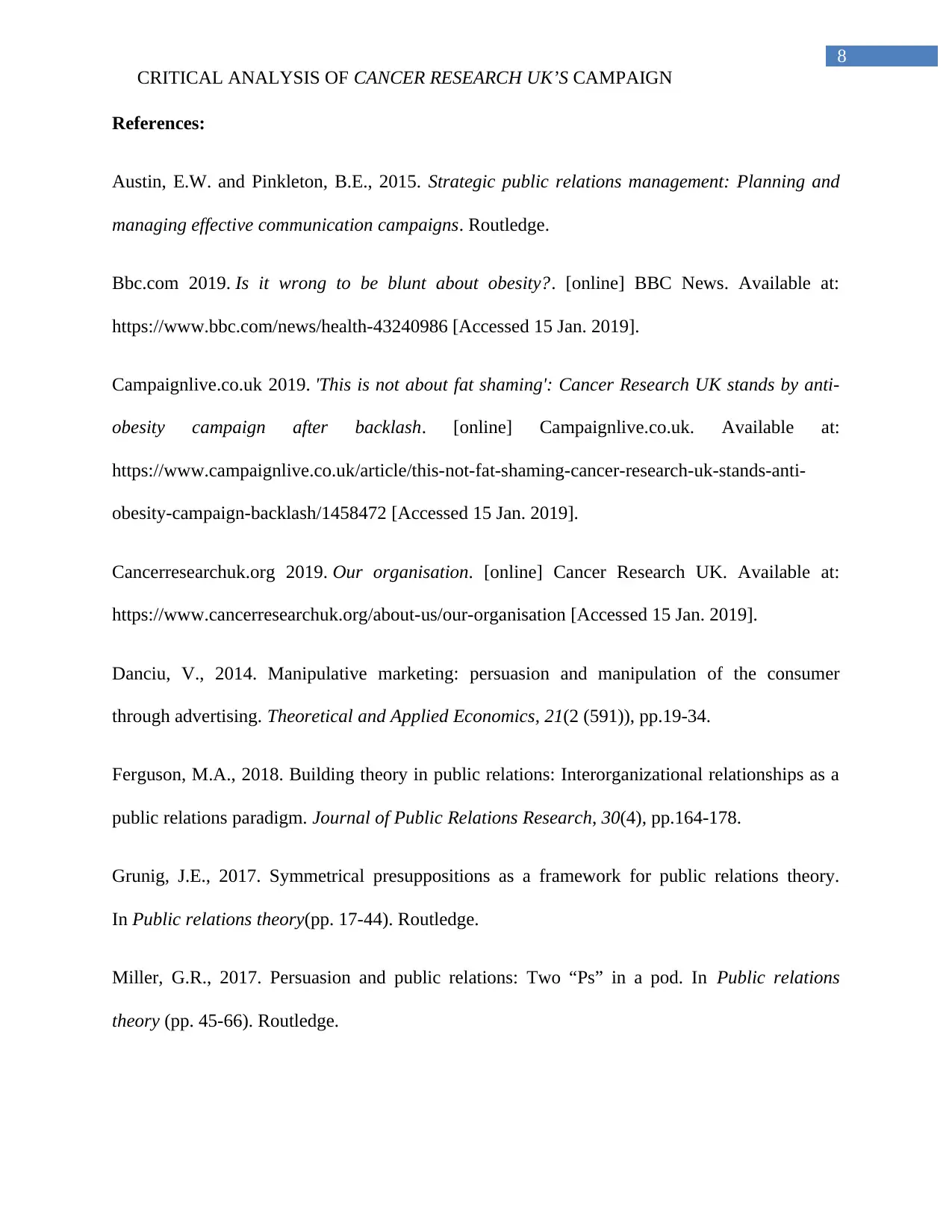
8
CRITICAL ANALYSIS OF CANCER RESEARCH UK’S CAMPAIGN
References:
Austin, E.W. and Pinkleton, B.E., 2015. Strategic public relations management: Planning and
managing effective communication campaigns. Routledge.
Bbc.com 2019. Is it wrong to be blunt about obesity?. [online] BBC News. Available at:
https://www.bbc.com/news/health-43240986 [Accessed 15 Jan. 2019].
Campaignlive.co.uk 2019. 'This is not about fat shaming': Cancer Research UK stands by anti-
obesity campaign after backlash. [online] Campaignlive.co.uk. Available at:
https://www.campaignlive.co.uk/article/this-not-fat-shaming-cancer-research-uk-stands-anti-
obesity-campaign-backlash/1458472 [Accessed 15 Jan. 2019].
Cancerresearchuk.org 2019. Our organisation. [online] Cancer Research UK. Available at:
https://www.cancerresearchuk.org/about-us/our-organisation [Accessed 15 Jan. 2019].
Danciu, V., 2014. Manipulative marketing: persuasion and manipulation of the consumer
through advertising. Theoretical and Applied Economics, 21(2 (591)), pp.19-34.
Ferguson, M.A., 2018. Building theory in public relations: Interorganizational relationships as a
public relations paradigm. Journal of Public Relations Research, 30(4), pp.164-178.
Grunig, J.E., 2017. Symmetrical presuppositions as a framework for public relations theory.
In Public relations theory(pp. 17-44). Routledge.
Miller, G.R., 2017. Persuasion and public relations: Two “Ps” in a pod. In Public relations
theory (pp. 45-66). Routledge.
CRITICAL ANALYSIS OF CANCER RESEARCH UK’S CAMPAIGN
References:
Austin, E.W. and Pinkleton, B.E., 2015. Strategic public relations management: Planning and
managing effective communication campaigns. Routledge.
Bbc.com 2019. Is it wrong to be blunt about obesity?. [online] BBC News. Available at:
https://www.bbc.com/news/health-43240986 [Accessed 15 Jan. 2019].
Campaignlive.co.uk 2019. 'This is not about fat shaming': Cancer Research UK stands by anti-
obesity campaign after backlash. [online] Campaignlive.co.uk. Available at:
https://www.campaignlive.co.uk/article/this-not-fat-shaming-cancer-research-uk-stands-anti-
obesity-campaign-backlash/1458472 [Accessed 15 Jan. 2019].
Cancerresearchuk.org 2019. Our organisation. [online] Cancer Research UK. Available at:
https://www.cancerresearchuk.org/about-us/our-organisation [Accessed 15 Jan. 2019].
Danciu, V., 2014. Manipulative marketing: persuasion and manipulation of the consumer
through advertising. Theoretical and Applied Economics, 21(2 (591)), pp.19-34.
Ferguson, M.A., 2018. Building theory in public relations: Interorganizational relationships as a
public relations paradigm. Journal of Public Relations Research, 30(4), pp.164-178.
Grunig, J.E., 2017. Symmetrical presuppositions as a framework for public relations theory.
In Public relations theory(pp. 17-44). Routledge.
Miller, G.R., 2017. Persuasion and public relations: Two “Ps” in a pod. In Public relations
theory (pp. 45-66). Routledge.
⊘ This is a preview!⊘
Do you want full access?
Subscribe today to unlock all pages.

Trusted by 1+ million students worldwide
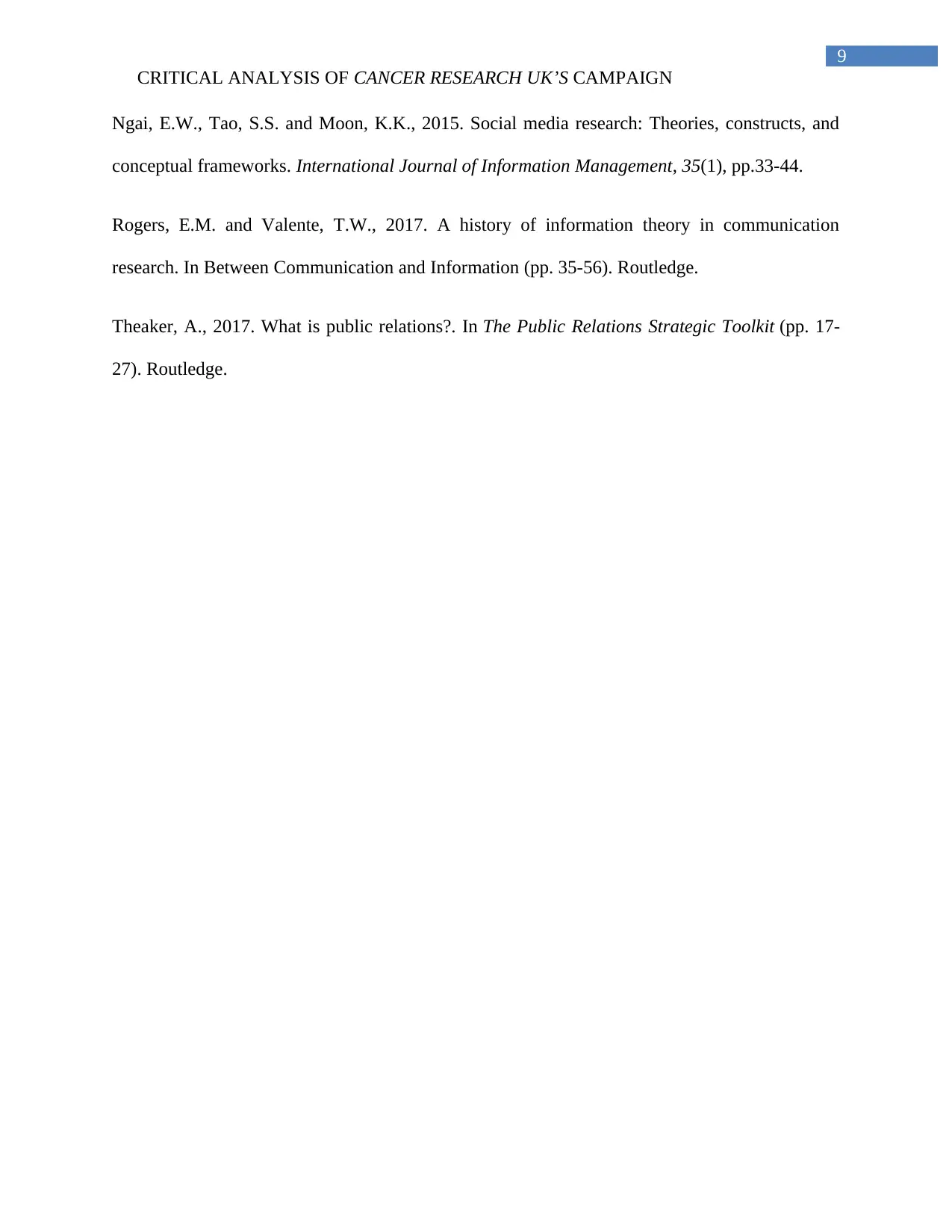
9
CRITICAL ANALYSIS OF CANCER RESEARCH UK’S CAMPAIGN
Ngai, E.W., Tao, S.S. and Moon, K.K., 2015. Social media research: Theories, constructs, and
conceptual frameworks. International Journal of Information Management, 35(1), pp.33-44.
Rogers, E.M. and Valente, T.W., 2017. A history of information theory in communication
research. In Between Communication and Information (pp. 35-56). Routledge.
Theaker, A., 2017. What is public relations?. In The Public Relations Strategic Toolkit (pp. 17-
27). Routledge.
CRITICAL ANALYSIS OF CANCER RESEARCH UK’S CAMPAIGN
Ngai, E.W., Tao, S.S. and Moon, K.K., 2015. Social media research: Theories, constructs, and
conceptual frameworks. International Journal of Information Management, 35(1), pp.33-44.
Rogers, E.M. and Valente, T.W., 2017. A history of information theory in communication
research. In Between Communication and Information (pp. 35-56). Routledge.
Theaker, A., 2017. What is public relations?. In The Public Relations Strategic Toolkit (pp. 17-
27). Routledge.
1 out of 10
Related Documents
Your All-in-One AI-Powered Toolkit for Academic Success.
+13062052269
info@desklib.com
Available 24*7 on WhatsApp / Email
![[object Object]](/_next/static/media/star-bottom.7253800d.svg)
Unlock your academic potential
Copyright © 2020–2025 A2Z Services. All Rights Reserved. Developed and managed by ZUCOL.





